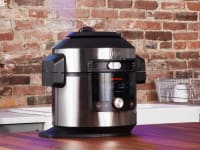These gorgeous portable cooktops are the perfect gift for people who love to cook
We put two popular portable hot plates to the test
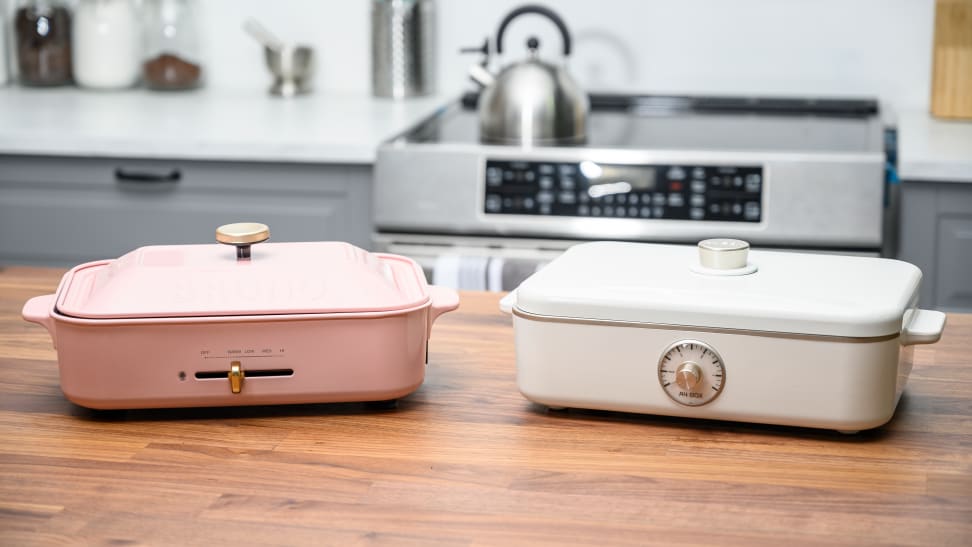 Credit:
Reviewed / Betsey Goldwasser
Credit:
Reviewed / Betsey Goldwasser
Products are chosen independently by our editors. Purchases made through our links may earn us a commission.
Some days I feel motivated enough to cook up a storm—but other days, the fear of cleaning up the mess is intense enough to discourage me from touching my pots and pans at all. I've dreamed of a cooktop that won't wear grease like a medal and long been disappointed.
Then I came across portable hot plates. These single-burner cooktops are designed to prepare quick meals that require very limited clean-up, and they can be transported for use in small kitchens, hotels, and rental units. While researching, both the Bruno and A4Box cooktops caught my attention—with their aesthetically-pleasing pastel colors and unique design that let them convert into slow cookers, indoor grills, and breakfast griddles, they were unlike anything I'd seen before.
To find out which is worth the investment, I put both hot plates to the test.
How do the A4Box and Bruno work?
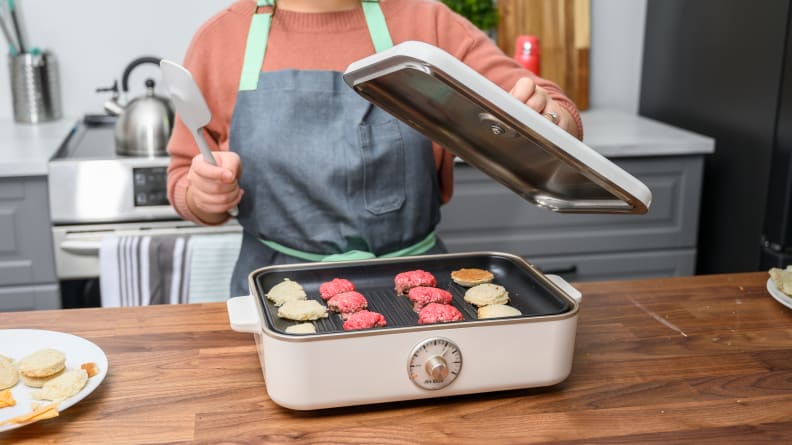
These hot plates are essentially indoor grills with multiple surface options.
Marketed as multifunctional hot plates, both the Bruno and A4Box consist of a heating base and uniquely fitted pots and pans. Bruno uses tubular coil-electric heating, which is located at the bottom of the plate. Having arrived from Japan in a neatly-packed box, the compact hot plate comes with a base, two nonstick pans (one for takoyaki, a Japanese snack, and one for grilling), a lid, and a wooden spatula.
Because the product is manufactured for the Japanese market, it uses 110 volts instead of 120 volts, which is the standard in the U.S. Therefore, you may need a transformer to alter your voltage and safely use internationally.
Once connected with the correct voltage, users can securely fit either pan on top of the heating area. Then, simply turn on the heat switch to start cooking, much like an indoor grill. There are four different temperature settings to choose from: Keep Warm, Low, Medium, and High.
The A4Box looks similar to the Bruno, but it’s slightly larger. It also incorporates an induction heating system, which is meant to help the plate cook faster and more evenly. It has four temperature settings: Low, Medium, High, and Keep Warm.
To start cooking, simply fit a pan snugly on top of the induction surface and make sure all corners are within the exterior of the base (except for the soup pot, which comes on top of the base because of its depth). To switch pans while they’re still hot, you can use the finger mitts included with the box. There’s no need to worry about switching the heat off while doing the swap, thanks to the induction heating system.
We cooked with the A4Box and Bruno—here’s how they compare
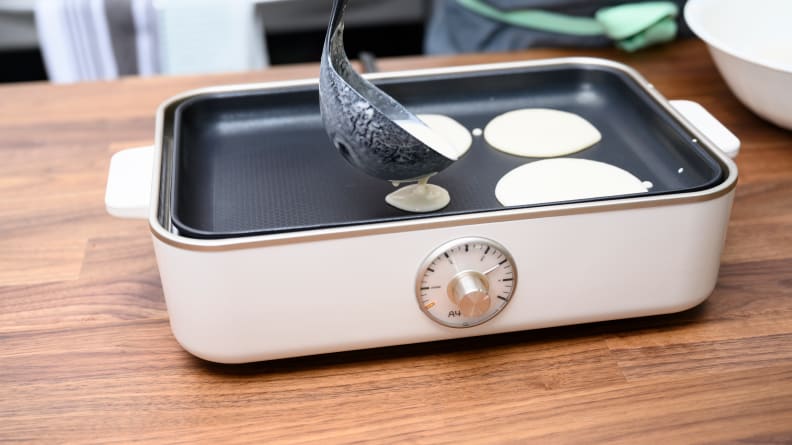
We compared the two hot plates—here's what happened.
To see how these hot plates stack up, we fried eggs, flipped pancakes, grilled bite-sized burgers, and sautéed asparagus on each and compared the results.
In the pancake test, the Bruno managed to fit four pancakes tightly, while the A4Box was able to fit six pancakes without feeling too jammed. It took the Bruno plate six minutes to make an egg at medium-high heat, and the A4Box about three minutes at a similar temperature setting.
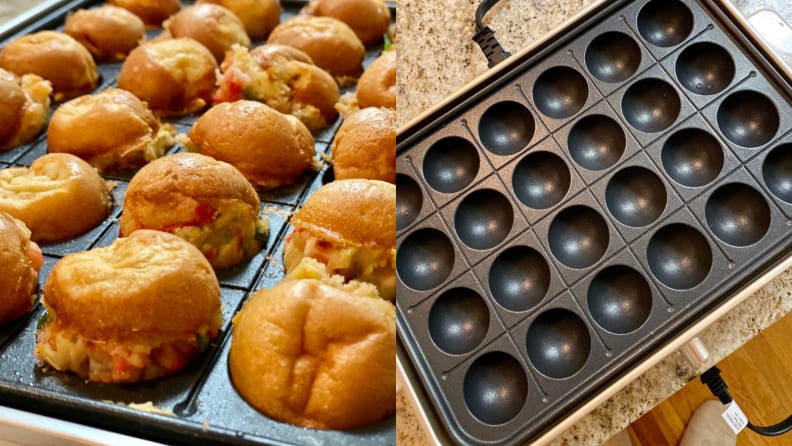
Thanks to its nonstick coating, this plate is perfect for making takoyaki.
In the pan with ball-shaped divets, we made a few batches of takoyaki, which is popular, ball-shaped street food from Japan. The traditional recipe contains small chunks of octopus meat, but you can also use ham, eggs. Typically, this specialty pan is made of cast iron with half-spherical molds as big as meatballs. The A4Box and Bruno pans both contain 24 molds and are made of aluminum die-cast with nonstick coating.
In our tests, we found the two hot plates took about the same time to turn the takoyaki batter into a batch of uniform-looking, delicious snacks, which was 20 minutes from start to finish. However, the Bruno had significantly more hot spots on the outer edges than the A4Box.
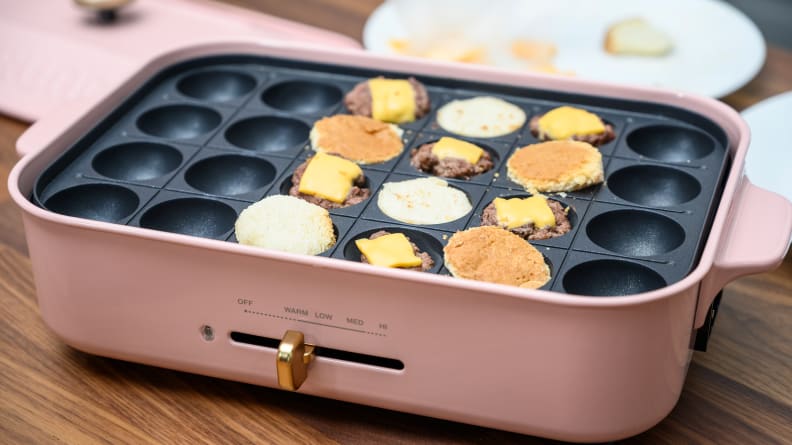
If making takoyaki sounds too complicated, you can also make sliders with the takoyaki pan.
Although their primary selling point might be their compact size, these appliances are also branded as new, interactive ways to approach tabletop cooking, so we tested their hotpot capability at a dinner party. Somewhat like fondue, Asian-style hotpot lets guests place fresh ingredients into a pot of broth until fully cooked.
We found that Bruno’s soup dish isn’t deep and wide enough for a group larger than three, while the one from A4Box can comfortably accommodate five to six people sitting around the pot. As a result of its induction heating technology, the A4Box was able to bring three quarts of broth to boil in just three minutes, while the Bruno took much longer. Both Bruno and A4Box were able to keep the broth at a simmer when adjusted to medium heat. The highest temperature both devices can reach is 482°F.
In addition to frying and making hotpot, both plates are also capable of sautéing, slow cooking, and making stews.
What accessories do they come with?
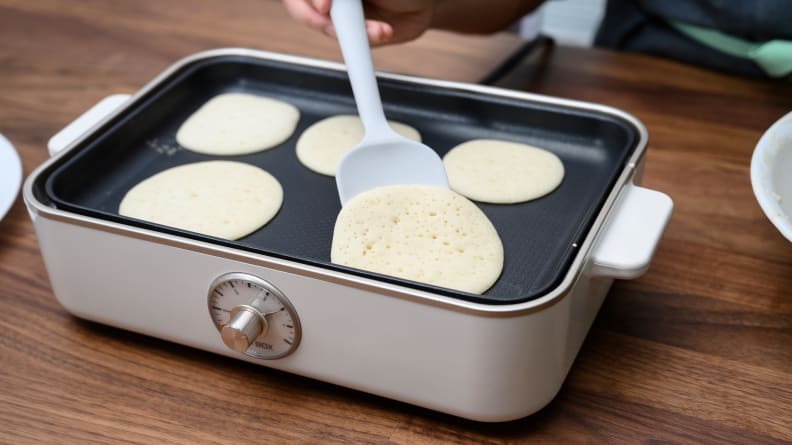
The A4Box comes with more useful accessories.
The Bruno hot plate’s only accessory is a wooden spatula, which doubles as a tool to help users change pans when cooking, according to its instructions. However, I didn’t find the tool to be useful, as I still needed oven mitts to safely swap pans out while they were sizzling hot.
Unlike Bruno, A4Box has multiple tools that are designed to help people who are new to this type of cooking device to get a head start, including a pair of silicone finger mitts, a teaspoon, a tablespoon, and a silicone spatula. Having those tools included guarantees I can bring the box anywhere and start cooking immediately.
How much do they cost?
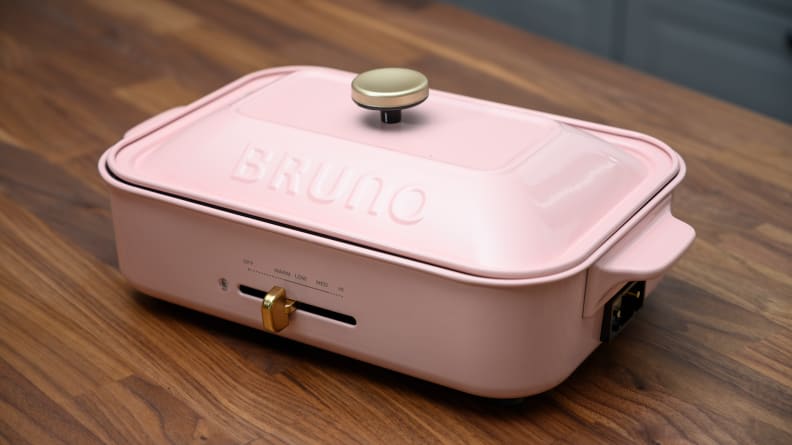
The Bruno is less expensive than the A4Box, but it may require a transformer.
The Bruno compact hot plate, which comes with two pans, costs $125. You can also buy additional pans separately, such as a a ceramic-coated soup pot for $50 and a ridged grill pan for $35.
Bruno also offers a complete set, which includes the base and five pans, for $295. The set includes a soup pot, a grill pan, and a disc pan. In addition to the cost of the hot plate itself, you may need to factor in the cost of a transformer to be able to use it in the United States, which on average costs around $100.
The A4Box is more expensive than Bruno at an upfront cost of $249, but it’s compatible with the standard U.S. power supply. Like Bruno, you can purchase additional pans on their website, but only in a three-pan combo set for $89. This set includes a takoyaki pan, a ceramic-coated soup pot, and a grill pan with six discs that allows you to cook eggs, make pancakes, and fry buns.
Bruno vs. A4Box: The final verdict
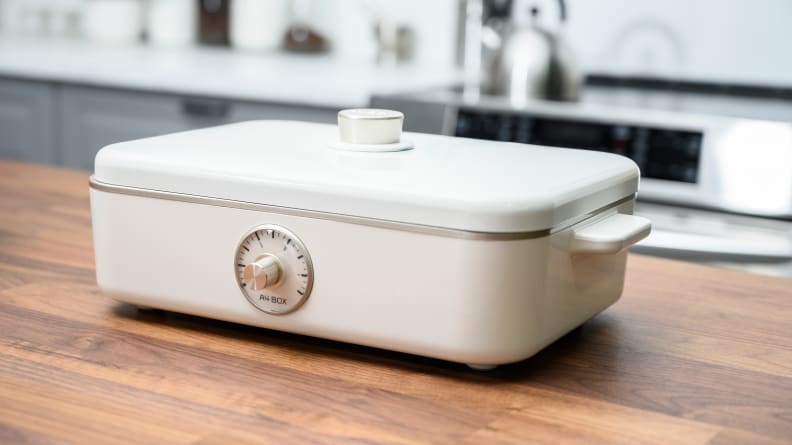
The A4Box better suits my needs.
Although I love the unique, charming appearance of the Bruno, the A4Box better suits my needs because of its larger cooking surface, useful accessories, and speedy heating system. Unlike many portable induction burners, A4Box doesn’t require you to purchase additional compatible pots and pans.
I also appreciate that the A4Box comes with two nonstick grill pans, which I find more useful than Bruno’s takoyaki-grill pan combo. Don’t get me wrong—I love making takoyaki and watching the batter form into ball shapes. But do I love them enough to cook them on a daily basis, let alone when I travel? When it comes to everyday quick meals, I’d rather have two pans I can use interchangeably.
In terms of cleaning, the A4Box is a better choice because the flat induction surface is easy to wipe down, as opposed to Bruno’s coil-electric system that becomes exposed once the pans are removed. The heating part is prone to get foods stuck when sauces or soups overflow the pan. Overflowing hasn’t happened to me yet, but I can imagine it’d be painful to clean up the grease as I’d have to dig into the machine.
Is a portable cooktop right for you?
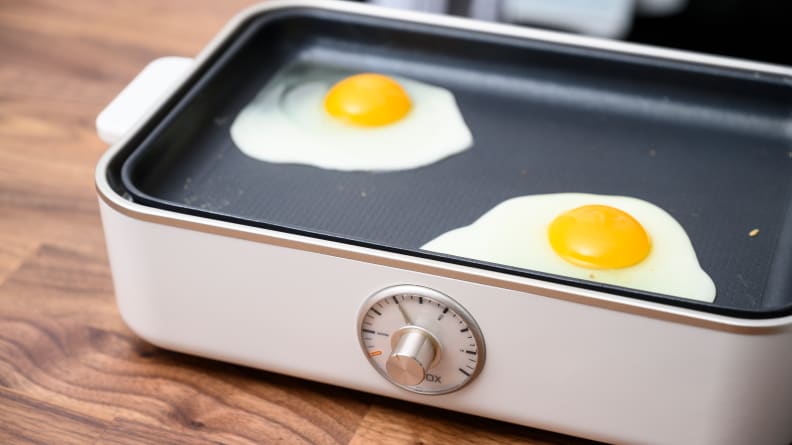
I loved how easy it was to cook with these hot plates—and clean-up was a breeze.
If you’re a new grad starting a chapter of your life in a tiny kitchen or someone who likes to entertain, a portable cooktop like the A4Box might be right for you. They’re also great for travelers, campers, and glampers who still have a source of electricity. And for college students who don’t have access to a full kitchen, these cooktops can fix a quick meal without making a mess, dorm regulations permitting.
Regardless of the circumstances, these portable hot plates could make a great addition to your kitchen. Looking for more multitasking gadgets? Check out our reviews on multicookers and slow cookers.

